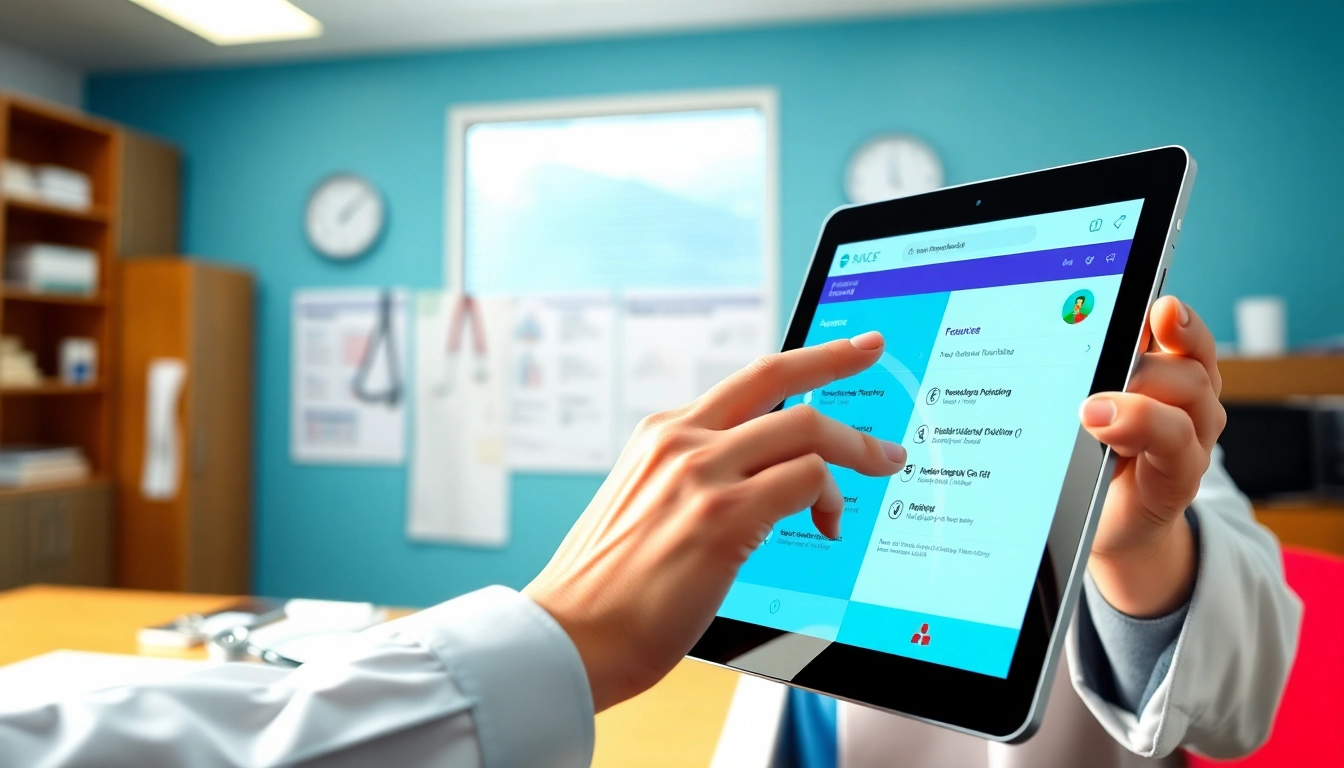Understanding Eprescribing Software
What is Eprescribing Software?
Eprescribing software is a digital solution that allows healthcare providers to electronically send prescriptions to pharmacies. This entails the entire workflow, from patient information input to the transmission of a prescription, making it a more efficient alternative to traditional paper prescriptions. The evolution of healthcare technology has ushered in this form of innovation, which is integral to improving patient care and reducing errors associated with handwritten prescriptions. One of the key features of eprescribing software is its capability to ensure accuracy and eliminate confusion often caused by illegible handwriting or misinformation.
Benefits of Eprescribing Software
The adoption of eprescribing software has led to significant benefits in healthcare systems. Firstly, it enhances the efficiency of the prescription process, considerably reducing the time healthcare providers spend on writing and transmitting prescriptions. Moreover, it minimizes the risk of prescribing errors, which can have devastating effects on patient safety. By integrating with electronic health records (EHR) and pharmacy management systems, eprescribing software allows for real-time updates regarding patient data and medication histories, leading to better-informed prescribing decisions. Additionally, this technology fosters improved patient adherence to medication regimens by facilitating easier communication between patients and healthcare providers.
How Eprescribing Software Works
Eprescribing software operates through a user-friendly interface that provides healthcare professionals with access to various tools for prescription management. When a healthcare provider determines a medication for a patient, they input the relevant details into the eprescribing platform. The system then checks for potential drug interactions, allergies, and insurance coverage options before transmitting the prescription directly to the selected pharmacy. This streamlined process not only saves time but also enhances the overall patient experience. To learn more about the features of eprescribing software, it is essential to delve deeper into its core functionalities.
Core Features of Eprescribing Software
Electronic Prescription Transmission
One of the standout features of eprescribing software is its ability to electronically transmit prescriptions from the healthcare provider’s office to the pharmacy of the patient’s choice. This process is not only quicker but also reduces the chances of errors that can occur with paper prescriptions. Electronic transmissions are carried out through secure channels that comply with HIPAA regulations, ensuring that patient information remains confidential. Furthermore, this feature enables real-time tracking of prescriptions, allowing both pharmacists and physicians to coordinate care effectively.
Medication History Access
Eprescribing software provides healthcare providers with immediate access to comprehensive medication histories for their patients. This function is crucial in preventing adverse drug interactions and ensuring that new prescriptions are safe and appropriate. By examining a patient’s past medications, providers can make more informed decisions about the treatment plans. This feature also enhances the continuity of care, as clinicians can easily see what medications a patient has previously been prescribed by other providers, thereby reducing the chance of double prescribing or neglecting vital therapeutic history.
Drug Interaction Alerts
To further bolster patient safety, eprescribing software includes drug interaction alerts that notify healthcare providers of potential risks associated with certain medications. When a provider attempts to prescribe a new medication, the system automatically checks against the patient’s current list of drugs and flags any harmful interactions. This proactive approach is essential in improving patient outcomes and reducing hospitalizations due to adverse reactions. The alert system acts as a vital safety net for providers, ensuring that they can deliver the highest standard of care.
Advanced Features of Eprescribing Software
Real-Time Formulary Checks
To optimize the prescribing process, many eprescribing systems incorporate real-time formulary checks, which provide providers with up-to-date information regarding patients’ medication coverage. This feature allows clinicians to verify whether a prescribed medication is covered by the patient’s insurance plan, which influences adherence and ultimately, therapeutic success. By accessing formulary information at the point-of-care, healthcare professionals can suggest alternative therapies if a medication is not covered, thus improving access to necessary treatments.
Secure Messaging Systems
Integrating secure messaging systems within eprescribing software adds an essential layer of communication between healthcare providers and patients. Through this feature, providers can send messages about prescription status, respond to patient inquiries, or discuss potential changes in treatment. This improves transparency and helps bridge gaps in communication, ensuring that patients feel informed and involved in their care. Secure messaging also adheres to privacy regulations, safeguarding patient information during correspondence.
Automated Refills and Renewals
Automated refills and renewals streamline the process of managing chronic conditions. With this feature, patients can benefit from timely medication refills without the need for redundant office visits. When a patient’s medication is nearing completion, the system can automatically generate requests for refills based on predefined criteria. This not only saves time for healthcare professionals but also promotes adherence among patients, ensuring they do not run out of necessary medications. The feature also allows providers to review refill requests, thereby maintaining appropriate oversight and avoiding misuse of medication.
Best Practices for Utilizing Eprescribing Software
Training Healthcare Providers
Proper training for healthcare providers is fundamental to successfully implementing eprescribing software in any medical practice. Investing in comprehensive training programs ensures that all staff members are proficient in using the software features effectively. Regular training sessions help address any updates or changes to the system and reinforce the importance of adherence to best practices and patient data security. Emphasizing a culture of continual learning can significantly enhance the overall efficacy of the eprescribing system.
Integrating with Healthcare Systems
Eprescribing software works best when seamlessly integrated with existing healthcare systems, like EHRs and practice management tools. Integration facilitates smoother workflows and minimizes disruptions during the prescribing process. It is crucial for practices to plan integration strategies that allow for data exchange between systems, fostering a comprehensive view of patient care. This holistic approach enhances the accessibility of patient records and medication histories, ultimately leading to improved clinical efficiency.
Ensuring Compliance and Security
Engaging with eprescribing software necessitates a commitment to compliance and security. Healthcare providers must ensure that their systems adhere to regulations set forth by governing bodies. This includes maintaining HIPAA compliance, safeguarding patient information, and implementing secure electronic transmission methods. Regular audits and security assessments should be conducted to identify potential vulnerabilities in the system. By prioritizing compliance and security measures, healthcare providers can protect their patients and uphold the integrity of their practice.
Future Trends in Eprescribing Software
AI and Machine Learning Integration
The future of eprescribing software is likely to be shaped significantly by advancements in artificial intelligence (AI) and machine learning. These technologies can analyze large datasets to predict patient needs and improve prescribing accuracy. For example, AI can assist in suggesting tailored medication plans based on a patient’s medical history, genetic factors, and lifestyle choices. As machine learning algorithms evolve, they can continually refine prescribing processes, reduce errors, and enhance personalized medicine initiatives.
The Role of Telemedicine in Eprescribing
As telemedicine gains traction, its interplay with eprescribing software becomes increasingly essential. Telehealth consultations often require immediate prescribing solutions, making efficient eprescribing capabilities critical. The integration allows patients to receive prescriptions after virtual visits quickly, enhancing their overall healthcare experience. Enhanced connectivity between telemedicine platforms and eprescribing software ensures that medication recommendations are issued seamlessly, thus promoting continuity of care.
Patient Engagement and Experience Enhancements
One of the most promising future trends of eprescribing software involves increased patient engagement. Modern systems aim to empower patients by providing easier access to their prescription information, educational resources, and reminders for medication adherence. Through patient portals, individuals can actively participate in managing their health, view upcoming refill dates, and communicate directly with their healthcare providers. The shift towards a patient-centered approach, where individuals are engaged and informed, can lead to improved health outcomes and satisfaction levels.



